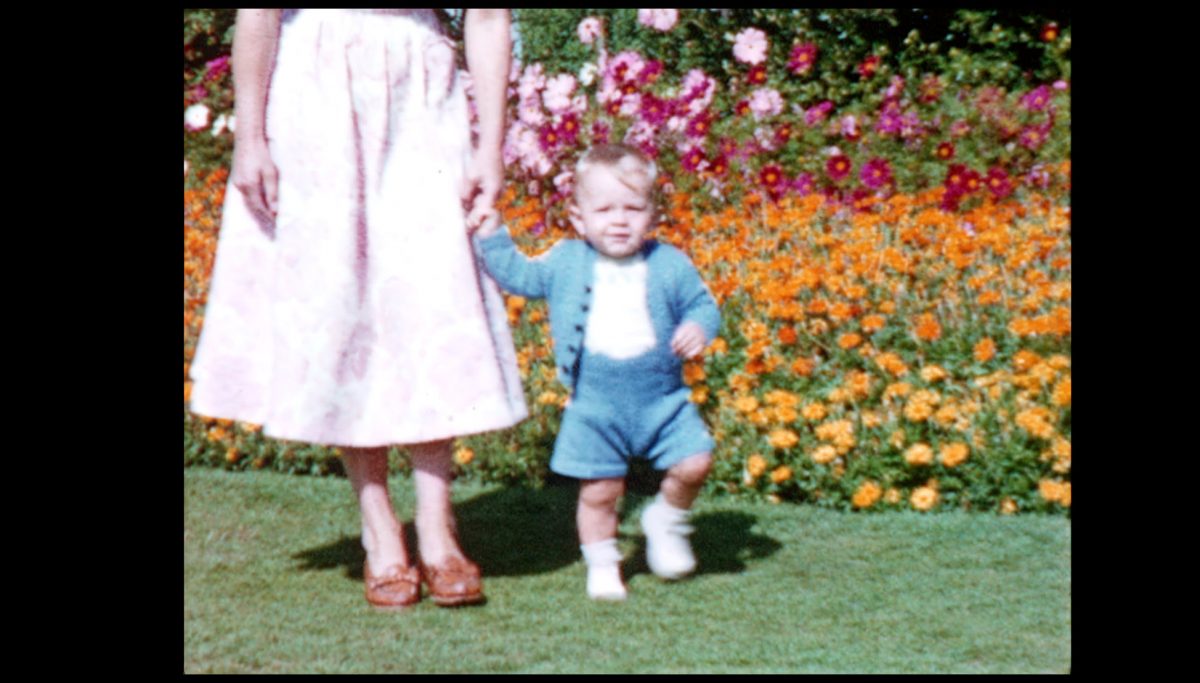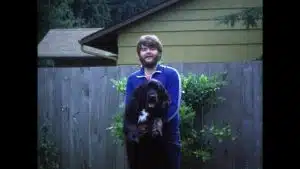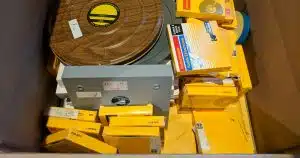Putting things in digital form means more safety nets.

This is a story of why I go digital at every opportunity.
For years, I’ve had a collection of 8mm and Super-8 movies stored in my basement. As technology progressed and the projector deteriorated, I realized that the only way I would ever watch them again would be to get them converted to a digital format.
That involved shipping them across the country. If that makes you nervous, it absolutely should. It did me.
Become a Patron of Ask Leo! and go ad-free!

My backup story
- I had multiple 8mm and Super-8 movies transferred to digital form.
- One package was lost on return.
- The transfer company kept a digital backup, which I was able to download instead.
- Digital forms are much easier to back up and keep safe.
- The “lost” originals were recovered due to the kindness of a stranger.
Movie transfers: Cinepost
Because this was so important, I researched the most promising services for digital movie transfers. I settled on Cinepost.
I’m glad I did. Not only are the transfers of high quality, but they did a great job keeping me posted, responding to my requests, and just being there for me. That last item (and one more thing) is important for reasons that will become apparent below.
To be extra clear: I would happily use Cinepost again and highly recommend them to anyone considering a similar project.1
Three waves
I ended up sending a selection of my movies in three waves, though it was originally intended to be only two.
First, I sent in three movies — two older 8mm films of me as a small child and one Super-8 — to test the process. You can see the results of the 8mm transfer on my personal blog post, Little Leo. These were the most important films to me to preserve in some fashion.
While it was a little risky to send these in as part of a “trial run”, the results exceeded my expectations. The original films were returned along with the digital copies on a USB hard drive.
Once I saw the results, I went all in, boxed up the remaining 26 reels (2,000 feet) of Super-8 film, and sent it off for conversion. This time, the hard disk was returned separately so I could review the results before the originals made their way back to me in case anything needed to be redone. The results were once again perfect.
Of course, as I was reviewing the results of the larger batch of movies, I discovered I’d overlooked four more. I sent those in and told the folks at Cinepost they could just send everything back once these final four had been converted.
That’s when things got interesting.
Return shipment fail
While traveling, I received email notification from the shipping company2 that the package, which required a signature, had been delivered to my home. My wife, however, hadn’t signed for anything and knew nothing about it.
When I returned home, the package was nowhere to be seen.
At this point, I had the conversions of all but those last four films. They were lost, and since they’d been shipped back together, both their digital and original forms were lost.
Let me say that again: everything was lost.
But then I remembered something the folks at Cinepost had mentioned.
Backups to the rescue
Cinepost indicated the digital conversions remain on their equipment for some time after being returned to the customer.

Put another way, they kept a backup. The movies were never “in only one place;” they were in two: the lost package and at least one machine across the country from me at Cinepost.
We made arrangements to begin transferring those files via the internet. They were large, so they took some time to upload, but they existed.
These movies were films I didn’t even realize existed. They were films of me and our first dog, a Newfoundland named Elsie, taken not long after my wife and I were married. As you can imagine, they were incredibly touching for me to see.
More backups
Now that the digital copies were once again in my control, they fell into my own backup strategy. In short, that means:
- Copies on at least two machines here at home. (Actually, three copies on three drives across two machines.)
- Copies uploaded off-site in the form of cloud storage. (Currently Dropbox.)
All of that happened automatically, of course, within a few days of the digital copies arriving here.
Even if I never got my originals back, I had the digital copies, and they were backed up.
This is why I love going digital and backing up
That’s worth repeating. Even if the originals were lost forever:
- I have the digital copies.
- I can, and do, back them up to my heart’s content.
To be completely honest, I wasn’t sure if the originals would ever see the light of day again.
But this is why I love digital information and digital conversion (or copying, if you like) of analog or pre-digital media: it opens so many possibilities. Not only can I share what I have (as in my post), but I can back it up. I’m no longer reliant on one and only one copy of the movies in a format that has a finite lifespan and can be difficult to access.
The kindness of strangers
I’d begun the lost-package tracking process with Cinepost and the delivery service to see if we could track down what happened to the originals.
Then there was a knock at my door. A stranger, holding a package.

Holding the package.
The package had inexplicably been delivered to an address three miles away. Coincidentally, this person had also been out of town, and his neighbor had taken delivery and signed for the package without looking at it closely. Once the package had been opened, of course, it was clear it had been misdelivered.
He took the time to deliver it to the correct address.
Sadly, being so surprised, I didn’t think to get his name — but I’m very, very grateful.
Do this
What are you at risk of losing because you have only a single copy?
What are you at risk of never being able to access again because media standards continue to evolve? (Who has an 8mm projector these days?)
What are you at risk of losing because it’s the only copy, and the mere act of viewing it causes it to wear and quite possibly literally tear?
What don’t you have backed up?
It’s worth considering.
Also worth considering: subscribing to Confident Computing! I can’t promise you more baby pix, but I can offer less frustration and more confidence, solutions, answers, and tips in your inbox every week.




This won’t add to the discussion so I won’t be upset when you delete it but I wanted to let you now I’m glad you started videoing these. Nice to put a face to the knowledge.
For me it was the bulb burning out on my dad’s 8 mm projector that got me going on this. I had to get digital copies. I opted to do it myself in the dark basement. Fortunately, my father-in-law also had an 8 mm projector. I used my HD video camera to record the film shown on the screen. And the camera’s mic picked up the whine of the projector and the clickety-clack of the sprockets. I think Leo’s quality is better than I was able to achieve, but I’m pleased with the results. They don’t look too bad, considering the original media. Note, that if you do try this yourself, I got better results by turning off the automatic camera adjustments and set a fixed focal length, etc.
I put the digital copies onto DVDs and gave them to my dad (they are his films after all). I have also copied them to an external hard drive. So I’ve got copies in at least 3 places (if you don’t count the clips on Facebook that my dad shared with my cousins).
Glad to hear that you got your originals back. This link documents the sad tale of 2 MS users who trusted MS OneDrive with their image collections:
https://answers.microsoft.com/en-us/msoffice/forum/msoffice_drive-mso_amobile-mso_mobapps/one-drive-account-hacked-and-microsoft-refusing-to/d9c76abb-3185-4d7f-b8a9-9c0d0d554256?messageId=2b6d289f-cf68-403d-a9ee-1ea669035586
These 2 people reported that their email accounts were hacked, taking control away from them. When they contacted MS, the final result was “too bad, so sad”. Even after they got control back the images were still lost …
I was under the (mistaken) impression that MS provided some sort of backup system for OneDrive. Based on these 2 cases, apparently that is a bad assumption. Very surprising too.
It is in no way surprising, and I’ve counselled on this repeatedly: if it’s only in one place, it’s not backed up, and cloud storage (ANY cloud storage) is one place. The backups OneDrive and Dropbox and Box and Google Drive and all the others have are for their use, for example if there are system failures. They’re not intended for people who lose their files in some other way. You and only you are responsible for backing up your files, and for maintaining your account security.
Having OneDrive or Dropbox syncing your files isn’t really a backup in the true sense because any files deleted on one will delete them on the other. They do serve as great short-term backups in-between daily incremental or differential backups, though.
Good article. for me it’s mainly about finding a balance of backing up/convenience combo. so I tend to backup family photos/videos (or anything I care about), with a bare minimum standard of two different copies on say two different hard drives (one hard drive is generally offline short of when I connect it for data backup). even if I am slacking a bit I do at least this as while there is still risks with this, at the least it’s reasonable data protection as it’s much better than only one copy which with one copy it’s a disaster waiting to happen.
that two hard drive stuff is typically what I do since it’s easy enough to do with minimal effort (like time spent/convenience vs data security combo). but on higher importance stuff (family photos/videos) ill do the usual minimum of two hard drives + backups on quality (Taiyo Yuden/Verbatim) optical media (CD/DVD), and preferably two different kinds of optical media (Taiyo Yuden/Verbatim) as the odds of me losing data with that combination is slim, especially outside of a natural disaster. but I do admit I am slacking a bit on backing up family photos/videos to DVD as a basic data disc a computer can read (but I got the bulk of it backed up).
while I know CD/DVD is not as popular as it once was, it’s still a reliable way to backup data (as long as a person does not have TOO much to backup as then it starts to become a bit less practical) for long term storage. they should last ‘at least’ 10-20+ years for a conservative figure as I have media around 10-15 years old and they are still going strong as I checked with KProbe and they are pretty much the same as when I burned them as based on a KProbe scan I got a rough idea of when a optical disc will have trouble or fail to read the disc and they are no where near that point so I expect them to last for the foreseeable future, probably at least another 10-20+ years and could be well over that for all I know. because at my age (early 40’s) I figure I won’t need stuff more than around 40 years or so max as I figure even if I lived to 100 or so, which is probably a best case scenario, I might not even care that much about this stuff at that point. but I suspect ill care for at least another 10-20 years and optical media will likely still be reasonably accessible in that time unless there is a fairly drastic technology change in the next 5-10 years or so.
even in regards to technology changes… I feel CD/DVD media won’t be difficult to find drives that can read these disc for the foreseeable future especially as long as the SATA standard hangs around for many years to come and it should not be difficult to find CD/DVD drives that can read these discs for the foreseeable future. probably at least another 10 years from now for a conservative figure and could easily be well beyond that. even if they start to phase out the SATA port, it will probably bit quite a ways after that before software/computers are hard to find to access it. so all-in-all, I don’t expect it being a huge issue to find CD/DVD readers to read my important data for probably at least 2035-2040 time frame even if they started to phase out SATA in say the next 5-10 years.
but generally my important data I don’t want to lose I stick to the two hard drive method (with one hard drive being generally offline) short of family photos which I do hard drives and optical media, although I admit I am slacking a bit on backing up all of my family photos/videos to optical media but a good portion of it is backed up. I guess I might start to at least burning one copy to DVD (outside of the usual two hard drive setup), but I kind of like to at least sort of go through it a bit and clean out a little of the excess stuff I don’t care about as much before burning, but that ends up taking quite a bit of time so I semi-rarely do it. I suspect it will be more efficient use of my time to just either burn it and don’t worry about fine tuning it, or do a quick look through of it and only delete the really obvious stuff I don’t care about before burning to DVD.
but in my case… a natural disaster would be probably my biggest risk to irrecoverable data loss. because while I got a little bit backed up online, if my house got totally wiped out, since I use a password manager etc, I would likely be locked out of those accounts as even my main email is secured with a YubiKey and if I lost those (I got two since one I use in general and the other is a backup (stored in a safe) in case I lost my main YubiKey) in a natural disaster I would almost certainly be locked out of my accounts. but I guess I am banking on that not happening as short of that the risk of data loss etc for me should be low enough. not bulletproof, but not far from it especially with the two hard drive/optical media (preferably two copies on two different kinds of quality media) setup I use as that’s probably not far from bulletproof short of natural disaster or the like.
The fact that you can fall behind on your backups is an indication you are not properly backing up. You can keep your photos and other important data backed up to the cloud almost instanteneously with services like Dropbox, OneDrive, Google Drive, pCloud, or other online synchronization services. There’s also Carbonite and BackBlaze. If you prefer not to pay, you can use more than one free cloud sync service at the same time.
And of course, we strongly recommend an always connected backup drive running a system image backup which, even though you may not think you need it, makes it easy to restore your system after disk failure or malware. There are also files you may need that aren’t backed up using a cloud backup.